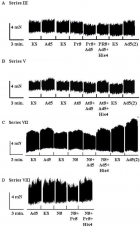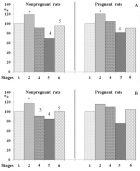Abstract
Research Article
Influence of Histidine on the contractility and adrenaline inotropic effect in the experiments with myocardium of right ventricular of Non pregnant and Pregnant Rats
Victor Tsirkin*, Alexander Nozdrachev, Julia Korotaeva and Grigorij Khodyrev
Published: 19 November, 2018 | Volume 3 - Issue 3 | Pages: 084-103
It was investigated contractility and adrenoreactivity of intact myocardium strips of right ventricular in experiment with 60 rats. They were assessed by the force of induce contraction and its changes under the influence of adrenaline (10-9 or 10-5 g / ml). Found that these indicators do not depend on the phases of the estrous cycle and the presence of pregnancy. Histidine (10-10-10-4 g / ml) did not increase the response to adrenalin (10-9 g / ml), but increased the force of the contractions in rats in progesterone dominance (trend) and pregnancy (statistically significant). Against the background of propranolol (10-8 g / mL) or atenolol (10-8, 10-6 g / mL), adrenaline (10-5 g / mL) instead of increasing the force of contraction reduced it (probably due to activation of beta3-, alpha1 - and alpha1 a2- adrenergic receptors), and histidine (10-4 g / mL) prevented this reduction, but does not restore full ability of adrenaline to exert a positive inotropic effect. On the background of nicergoline (10-8 g / mL or nicergoline and propranolol (10-8 g / mL), adrenaline (10-5 g / mL) did not alter the force of contraction, and histidine (10-4 g/mL) restore ability of adrenaline to exert a positive inotropic effect but only in the experiments with nicergoline. Concluded that histidine increases the efficiency of the activation of all three (beta1-, beta2- and beta3-) populations of myocardial beta-adrenoceptoprs, including at lower by adrenergic blockers. Therefore, histidine proposed as an antagonist of beta-adrenergic blockers and as resensitizator of these receptors.
Core Tip: In the experiments with strips of the right ventricle of 40 nonpregnant and 20 pregnant rats histidine (10-10-10-4 g /mL) did not increase the response to adrenaline (10-9 g / ml), but increased the force of contractions in pregnant rats. On the background of propranolol (10-8 g / mL) or atenolol (10-8, 10-6 g / mL), adrenaline (10-5g/mL) showed a negative inotropic effect, and histidine (10-4 g / mL) prevented it, but does not restore the ability of adrenaline to show positive inotropic effect,. i.e histidine exhibits the properties of the antagonist of beta-blockers and of resensitizator of beta-adrenoceptors
Read Full Article HTML DOI: 10.29328/journal.jccm.1001030 Cite this Article Read Full Article PDF
Keywords:
Myocardium; Adrenaline; Histidine; Adrenergic blockers; Estrous cycle; Pregnancy
References
- Nozdrachev AD, Tumanova TV, Dvoryanskij SA, Tsirkin VI, Darmov IV, et al. Activity of a series of amino acids as potential sensitizers of smooth muscle beta-receptors. Dokl Akad Nauk. 1998; 363: 133-136. Ref.: https://goo.gl/bxgV9L
- Sizova EN, Tsirkin VI, Tumanova TV. Influence of amino acids alimentary on contracts ability in beta-adreno- and M-cholinoreactivity of smooth muscles. Vopr Pitan 2008; 77: 26-32. Ref.: https://goo.gl/YJ3GC4
- Tumanova TV, Sizova EN, Tsirkin VI. Ability of L-histidine to decrease desensitization of the myometrium to epinephrine. Bull Exp Biol Med. 2004; 138: 321-324. Ref.: https://goo.gl/zVrZct
- Sizova EN, Tsirkin VI, Kostyaev AA. Effect of ozone exposure on contractile activity and chemoreactivity of uterus horns longitudinal muscles of nonpregnant rats. Ross Fiziol Zh Im I M Sechenova. 2003; 89: 427-435. Ref.: https://goo.gl/FXJ6Re
- Toropov AL, Nozdrachev AD, Tsirkin VI. Investigation of the mechanism of action of endogenous sensitizer of beta-adrenoceptor (ESBAR) and its analogs. Vestnik Sankt-Peterburgskogo universiteta, Ser. 3 (biologiya). 2011; 427-423.
- Tsirkin VI, Nozdrachev AD, Toropov AL. An endogenous sensitizer of β-adrenergic receptors and its analogs in the experiments with rat myometrium reduce the β-adrenoblocking effect of obzidan. Dokl Biol Sci. 2010; 435: 375-380. Ref.: https://goo.gl/G1bzAb
- Penkina YuA, Nozdrachev AD, Tsirkin VI. Effect of human blood serum, histidine, tryptophan, tyrosine, mildronat and lysophosphatidylcholine on inotropic effect of adrenaline in the experiments with the frog and rat myocardium. Vestnik Sankt-Peterburgskogo universiteta. Seriya 3 (Biologiya). 2008; 1: 55-68.
- Tsirkin VI, Sizova EN, Kajsina IG, Kononova TN, Trukhin AN, et al. Heart rate variability during puberty and pregnancy. Rossijskij vestnik akushera-ginekologa. 2004; (2): 4-9.
- Korotaeva KN, Nozdrachev AD, Vyaznikov VA, Tsirkin VI. Effect of tyrosine, histidine, tryptophan, mildronat and human serum on the amplitude of caused contractions of human cardiomyocytes and inotropic effect of adrenaline. Vestnik Sankt-Peterburgskogo universiteta. Ser. 3 (biologiya). 2011; 2: 45-57.
- Korotaeva KN, Tsirkin VI, Vyaznikov VA. Positive inotropic effect of tyrosine, histidine, and tryptophan in experiments on isolated human myocardium. Bull Exp Biol Med. 2012; 153: 51-53. Ref.: https://goo.gl/XW77dK
- Trukhin AN, Tsirkin VI, Sizova EN. Histidine increases beta-adrenoreactivity of myocardium in frogs. Bull Exp Biol Med. 2004; 138: 123-126. Ref.: https://goo.gl/BBxMsV
- Wehling M. [Pharmacology of beta blockers and their significance for therapy of hypertension]. [Article in German]. 2002; 27 (Suppl 1): 16-25. Ref.: https://goo.gl/9t7xQx
- Siryk-Bathgate A, Dabul S, Lymperopoulos A. Current and future Gprotein-coupled receptor signaling targets for heart failure therapy. Drug Des Devel Ther. 2013; 7: 1209-1222. Ref.: https://goo.gl/T9d9fe
- Shechtman MM. Guide extragenital pathology in pregnant women. Moskva: Triad. 2011; 896.
- Elzwiei F,Bassien-Capsa V,St-Louis J,Chorvatova A. Regulationof thesodium. Exp Physiol. 2013; 98: 183-192.
- Virgen-Ortiz A, Marin JL, Elizalde A, Castro E, Stefani E, Toro L, Muñiz J. Passive mechanical properties of cardiac tissues in heart hypertrophy during pregnancy. J Physiol Sci. 2009; 59: 391-396. Ref.: https://goo.gl/BfFM4D
- Kirshenblat YaD. Workshop on endocrinology. Moskva: Vysshaya shkola, 1969. 256.
- Dyban AP, Puchkov VF, Baranov VS. Laboratory mammals: mouse (Mus musculus), rat (Rattus norvegicus), rabbit (Oryctolagus cuniculus), hamster (Cricetus grisous) // Ob"ekty biologii razvitiya. Moskva: Nauka. 1975; S. 505-566. Ref.: https://goo.gl/PDgjSq
- Glantz S. Biomedical Statistics. Moskva: Praktika. 1999; 459.
- Flores A, Velasco J, Gallegos AI, Mendoza FD, Everardo PM, et al. Acute effects of unilateral sectioning the superior ovariannerveofratswith unilateral ovariectomy on ovarian hormones (progesterone, testosterone andestradiol) levels vary during the estrous cycle. Reprod Biol Endocrinol. 2011; 9: 34. Ref.: https://goo.gl/RKjZj1
- Ouzounian JG, Elkayam U. Physiologic changes during normal pregnancy and delivery. Cardiol Clin. 2012; 30: 317-329. Ref.: https://goo.gl/fg78Ht
- Dmitrieva SL, Khlybova SV, Khodyrev GN, Tsirkin VI. Condition of the autonomic nervous system in women on the eve of term labor, in the latent phase of labor and the postpartum period and the pattern of labor contractile activity. Rossijskij vestnik akushera-ginekologa. 2012; 2: 12-17.
- Umar S, Nadadur R, Iorga A, Amjedi M, Matori H, et al. Cardiac structural and hemodynamic changes associated with physiological heart hypertrophy of pregnancy are reversed postpartum. J Appl Physiol .2012; 113: 1253-1259. Ref.: https://goo.gl/cBLiV8
- Baevsky RM. Analysis of HRV in space medicine Fiziologiya cheloveka. 2002; 28: 70-82.
- Dmitrieva SL, Khlybova SV, Khodyrev GN, Tsirkin VI. Heart rate variability at different stages of gestation Kirov: KOGUZ Medicinskij informacionno-analiticheskij centr. 2013; 1-132.
- Khlybova SV, Tsirkin VI, Dvoryanskij SA, Makarova IA, Trukhin AN. Heart rate variability in normal and complicated pregnancies. Fiziol Cheloveka. 2008; 34: 97-105. Ref.: https://goo.gl/CVePfj
- Khodyrev GN, Nozdrachev AD, Dmitrieva SL, Khlybova SV, Tsirkin VI, et al. Heart rate variability in women at different stages of the reproductive process. Vestnik Sankt-Peterburgskogo universiteta. Seriya 3. (biologiya). 2013; 2: 70-86.
- Pöyhönen-Alho M, Viitasalo M, Nicholls MG, Lindström BM, Väänänen H, et al. Imbalance of the autonomic nervous system at night in women with gestational diabetes. Diabet Med. 2010; 7: 988-994. Ref.: https://goo.gl/uKwviT
- Avakian ON. Pharmacological regulation of adrenergic function. Moskva: Medicina. 1988; 256.
- Bralet J, Didier J, Moreau D, Opie LH, Rochette L. Effect of alpha-adrenoceptor antagonists (phentolamine, nicergoline and prazosin) on reperfusion arrhythmias and noradrenaline release in perfused rat heart. Br J Pharmacol. 1985; 84: 9-18. Ref.: https://goo.gl/73yVjb
- Boismare F,Moore N,Decourt S,Paux G,Saligaut C,Chretien P. Potentiationby analpha-adrenolyticagent,nicergoline, of the ardiac effects of propranolol. Methods Find Exp Clin Pharmacol 1983; 5: 83-88. Ref.: https://goo.gl/DQ3p2K
- McGraw DW, Liggett SB. Molecular mechanisms of beta2-adrenergic receptor function and regulation. Proc Am Thorac Soc. 2005; 2: 292-296. Ref.: https://goo.gl/tTket5
- Kissling G, Blickle B, Ross C, Pascht U, Gulbins E. alpha1-adrenoceptor-mediated negative inotropy of adrenaline in rat myocardium. J Physiol. 1997; 499 (Pt 1): 195-205. Ref.: https://goo.gl/WbZTpX
- Chinkin AS. alpha1-adrenergic receptors of the heart Pedagogiko-psihologicheskie i mediko-biologicheskie problemy fizicheskoj kul'tury i sporta. 2006; 1: 1-30.
- Lefkowitz RJ. Historical review: a brief history and personal retrospective of seven-transmembrane receptors. Trends Pharmacol Sci. 2004; 25: 413-422. Ref.: https://goo.gl/K7bg91
- Pérez-Schindler J,Philp A,Hernandez-Cascales J. Pathophysiological relevance of the cardiac β2-adrenergic receptor and its potential as a therapeutic target to improve cardiac function. Eur J Pharmacol. 2013; 698: 39-47. Ref.: https://goo.gl/tQjjHU
- Gauthier C,Rozec B,Manoury B,Balligand JL. Beta-3 adrenoceptors as new therapeutic targets for cardiovascular pathologies. Curr Heart Fail Rep. 2018; 184-192. Ref.: https://goo.gl/KS3hah
- Niu X,Watts VL,Cingolani OH,Sivakumaran V,Leyton-Mange JS,et al. Cardioprotective effectof beta3-adrenergic receptor agonism:roleofneuronal nitric oxide synthase. J Am Coll Cardiol. 2012; 59: 1979-1987. Ref.: https://goo.gl/VMnTSA
- Chu C, Thai K, Park KW, Wang P, Makwana O, et al. Intraventricular and interventricular cellular heterogeneity of inotropic responses to α1-adrenergic stimulation. Am J Physiol Heart Circ Physiol. 2013; 304: H946-H953. Ref.: https://goo.gl/VsQySQ
- Kim JS, Kang HS, Kim JS. alpha1-adrenoceptor-mediated negative inotropic effect caused by intracellular ionic activities in guinea-pig papillary muscle. J Vet Med A Physiol Pathol Clin Med. 2005; 52: 498-505. Ref.: https://goo.gl/zevjb2
- Porter AC, Svensson SP, Stamer WD, Bahl JJ, Richman JG, et al. Alpha-2 adrenergic receptors stimulate actin organization in developing fetal rat cardiac myocytes. Life Sci. 2003; 72: 1455-1466. Ref.: https://goo.gl/jh5gEc
- Gilsbach R, Hein L. Are the pharmacology and physiology of α-adrenoceptors determined by α-heteroreceptors and autoreceptors respectively? Br J Pharmacol. 2012; 165: 90-102. Ref.: https://goo.gl/USnFRz
- Indolfi C, Piscione F, Villari B, Russolillo E, Rendina V, et al. Role of alpha 2-adrenoceptors in normal and atherosclerotic human coronary circulation. Circulation. 1992; 86: 1116-1124. Ref.: https://goo.gl/QcBi8z
- Woodiwiss AJ, Honeyman TW, Fenton RA, Dobson JG Jr. Adenosine A2a-receptor activationenhances cardiomyocyte shortening via Ca2+-independent and dependent mechanisms. Am J Physiol. 1999; 276 : H1434- H1441. Ref.: https://goo.gl/Qpch85
- Tavernier G, Toumaniantz G, Erfanian M, Heymann MF, Laurent K, et al. beta3-Adrenergic stimulation produces a decrease of cardiac contractility ex vivo in mice overexpressing the human beta3-adrenergic receptor. Cardiovasc Res. 2003; 59: 288-296. Ref.: https://goo.gl/wkdLf3
- Sillence MN, Hooper J, Zhou GH, Liu Q, Munn KJ. Characterization of porcine beta1- and beta2-adrenergic receptors in heart, skeletal muscle, andadipose tissue, and theidentificationof anatypical beta-adrenergic binding site. J Anim Sci. 2005; 83: 2339-2348. Ref.: https://goo.gl/1dC5d7
- Odnoshivkina YG, Petrov AM, Zefirov AL. The effects of β2 -adrenoreceptor activation on the contractility, Ca-signals and nitric oxide production in the mouse atria. Acta Naturae. 2011; 3: 103-112.
- Pott C, Steinritz D, Napp A, Bloch W, Schwinger RH, Brixius K. [On the function of beta3- adrenoceptors in the human heart: signal transduction, inotropic effect and the rapeutic prospects]. [Article in German] Wien Med Wochenschr. 2006; 156: 451-458. Ref.: https://goo.gl/Dc375U v
- Gorini C, Jameson H, Woerman AL, Perry DC, Mendelowitz D. Prenatal nicotine exposure enhances the trigeminocardiac reflex via serotonin receptor facilitation in brainstem pathways. J Appl Physiol. 2013; 115: 415-421. Ref.: https://goo.gl/on96FX
- Winblad B, Fioravanti M, Dolezal T, Logina I, Milanov IG, et al. Therapeutic use of nicergoline. Clin Drug Investig. 2008; 28: 533-552. Ref.: https://goo.gl/BM2hfM
- Sizova EN, Tsirkin VI. The physiological characteristics of the endogenous modulators of beta-adreno- and M-cholinoreactivity. Kirov: Vyatskij social'no-ehkonomicheskij institute. 2006: 1-183.
- Herrick-Davis K. Functional significance of serotonin receptor dimerization. Exp Brain Res. 2013; 230: 375-386. Ref.: https://goo.gl/YyBS9A
- Brinks H, Boucher M, Gao E, Chuprun JK, Pesant S, et al. Level of G protein-coupled receptor kinase-2 determines myocardial ischemia/reper fusion injury via pro- and anti-apoptotic mechanisms. Circ Res. 2010; 107: 1140-1149. Ref.: https://goo.gl/pL8pWs
- Wang Q,Zhao J,Brady AE,Feng J,Allen PB,et al. Spinophilinblocksarrestinactionsin vitroandin vivoatG protein-coupled receptors. Science2004; 304: 1940-1944. Ref.: https://goo.gl/Cu7ZpH
- Lopatin IuM, Dronova EP. [Clinical-pharmacoeconomical aspects of ß-adreno blockers use in patients with ischemic heart disease undergoing coronary artery bypass grafting]. [Article in Russian] Kardiologiia. 2010; 50: 15-22. Ref.: https://goo.gl/pf2id8
- Gordeev IG, Liusov VA, Il'ina EE, Baiandin NL, Kuznechevskiĭ FV. [Derangements of contractility of left ventricular myocardium in patients subjected to coronary bypass surgery. Methods of their correction]. [Article in Russian] Kardiologiia. 2007; 47: 22-24. Ref.: https://goo.gl/eCaHWW
- Guggilam A, Hutchinson KR, West TA, Kelly AP, Galantowicz ML, et al. In vivo and in vitro cardiac responses to beta-adrenergic stimulation involume-overload heart failure. J Mol Cell Cardiol. 2013; 57: 47-58. Ref.: https://goo.gl/SZpmjE
Figures:

Figure 1

Figure 2
Similar Articles
-
Thrombolysis, the only Optimally Rapid Reperfusion TreatmentVictor Gurewich*. Thrombolysis, the only Optimally Rapid Reperfusion Treatment. . 2017 doi: 10.29328/journal.jccm.1001010; 2: 029-034
-
A new heart: portraying the physiologic anatomo-functional reconstruction in ischemic cardiomyopathyMarco Cirillo*,Marco Campana,Anna Bressanelli,Giovanni Troise. A new heart: portraying the physiologic anatomo-functional reconstruction in ischemic cardiomyopathy. . 2017 doi: 10.29328/journal.jccm.1001016; 2: 063-067
-
Endogenous sensitizer of beta-adrenergic receptors (ESBAR) and its analogs (review)Victor Tsirkin*,Alexander Nozdrachev,Elena Sizova,Tatyana Polezhaeva,Svetlana Khlybova,Marina Morozova,Andrew Trukhin,Julia Korotaeva,Grigory Khodyrev. Endogenous sensitizer of beta-adrenergic receptors (ESBAR) and its analogs (review). . 2018 doi: 10.29328/journal.jccm.1001028; 3: 064-078
-
Pathological left ventricular hypertrophy and outflow tract obstruction in an infant of a diabetic mother: A case reportUjuanbi AS*,Onyeka CA,Yeibake WS, Oremodu T,Kunle-Olowu OE,Otaigbe BE. Pathological left ventricular hypertrophy and outflow tract obstruction in an infant of a diabetic mother: A case report. . 2020 doi: 10.29328/journal.jccm.1001085; 5: 047-050
-
Unusual and severe peripartum cardiomyopathy: A case reportLamanna B*,Vinciguerra M,Crupano FM,Cicinelli R,Cicinelli E,Vimercati A. Unusual and severe peripartum cardiomyopathy: A case report. . 2021 doi: 10.29328/journal.jccm.1001116; 6: 040-043
-
Influence of Histidine on the contractility and adrenaline inotropic effect in the experiments with myocardium of right ventricular of Non pregnant and Pregnant RatsVictor Tsirkin*,Alexander Nozdrachev,Julia Korotaeva,Grigorij Khodyrev. Influence of Histidine on the contractility and adrenaline inotropic effect in the experiments with myocardium of right ventricular of Non pregnant and Pregnant Rats . . 2018 doi: 10.29328/journal.jccm.1001030; 3: 084-103
-
The complex interplay in the regulation of cardiac pathophysiologic functionalities by protein kinases and phosphatasesChrysanthus Chukwuma Sr*. The complex interplay in the regulation of cardiac pathophysiologic functionalities by protein kinases and phosphatases. . 2021 doi: 10.29328/journal.jccm.1001118; 6: 048-054
-
Rats with Postinfarction Heart Failure: Effects of Propranolol Therapy on Intracellular Calcium Regulation and Left Ventricular FunctionHari Prasad Sonwani*. Rats with Postinfarction Heart Failure: Effects of Propranolol Therapy on Intracellular Calcium Regulation and Left Ventricular Function. . 2023 doi: 10.29328/journal.jccm.1001169; 8: 158-163
-
The Fulcrum of the Human Heart (Cardiac fulcrum)Jorge Carlos Trainini*, Mario Wernicke, Mario Beraudo, Alejandro Trainini. The Fulcrum of the Human Heart (Cardiac fulcrum). . 2024 doi: 10.29328/journal.jccm.1001171; 9: 001-005
-
Diagnosing Peripartum Cardiomyopathy in a Resource-Limited Setting, a Clinical Perspective: Case ReportTyfur Rahman*, Kazi Nazratun Nomany Tahia. Diagnosing Peripartum Cardiomyopathy in a Resource-Limited Setting, a Clinical Perspective: Case Report. . 2024 doi: 10.29328/journal.jccm.1001179; 9: 058-060
Recently Viewed
-
Trends in TeledentistryRudrakshi C*. Trends in Teledentistry. J Clin Adv Dent. 2020: doi: 10.29328/journal.jcad.1001014; 4: 004-005
-
Au26-35: A Special Geometrical Structure of Au33 (D2) Cluster with Highly Occupied - 14 Pairs of Double-State DegeneracyK Vishwanathan*. Au26-35: A Special Geometrical Structure of Au33 (D2) Cluster with Highly Occupied - 14 Pairs of Double-State Degeneracy. Ann Adv Chem. 2022: doi: 10.29328/journal.aac.1001035; 6: 063-080
-
Texture of Thin Films of Aluminum Nitride Produced by Magnetron SputteringStrunin Vladimir Ivanovich,Baranova Larisa Vasilievna*,Baisova Bibigul Tulegenovna. Texture of Thin Films of Aluminum Nitride Produced by Magnetron Sputtering. Int J Phys Res Appl. 2025: doi: 10.29328/journal.ijpra.1001106; 8: 013-016
-
Minimising Carbon Footprint in Anaesthesia PracticeNisha Gandhi and Abinav Sarvesh SPS*. Minimising Carbon Footprint in Anaesthesia Practice. Int J Clin Anesth Res. 2024: doi: 10.29328/journal.ijcar.1001025; 8: 005-007
-
On Friedman equation, quadratic laws and the geometry of our universeS Kalimuthu*. On Friedman equation, quadratic laws and the geometry of our universe. Int J Phys Res Appl. 2021: doi: 10.29328/journal.ijpra.1001041; 4: 048-050
Most Viewed
-
Evaluation of Biostimulants Based on Recovered Protein Hydrolysates from Animal By-products as Plant Growth EnhancersH Pérez-Aguilar*, M Lacruz-Asaro, F Arán-Ais. Evaluation of Biostimulants Based on Recovered Protein Hydrolysates from Animal By-products as Plant Growth Enhancers. J Plant Sci Phytopathol. 2023 doi: 10.29328/journal.jpsp.1001104; 7: 042-047
-
Sinonasal Myxoma Extending into the Orbit in a 4-Year Old: A Case PresentationJulian A Purrinos*, Ramzi Younis. Sinonasal Myxoma Extending into the Orbit in a 4-Year Old: A Case Presentation. Arch Case Rep. 2024 doi: 10.29328/journal.acr.1001099; 8: 075-077
-
Feasibility study of magnetic sensing for detecting single-neuron action potentialsDenis Tonini,Kai Wu,Renata Saha,Jian-Ping Wang*. Feasibility study of magnetic sensing for detecting single-neuron action potentials. Ann Biomed Sci Eng. 2022 doi: 10.29328/journal.abse.1001018; 6: 019-029
-
Pediatric Dysgerminoma: Unveiling a Rare Ovarian TumorFaten Limaiem*, Khalil Saffar, Ahmed Halouani. Pediatric Dysgerminoma: Unveiling a Rare Ovarian Tumor. Arch Case Rep. 2024 doi: 10.29328/journal.acr.1001087; 8: 010-013
-
Physical activity can change the physiological and psychological circumstances during COVID-19 pandemic: A narrative reviewKhashayar Maroufi*. Physical activity can change the physiological and psychological circumstances during COVID-19 pandemic: A narrative review. J Sports Med Ther. 2021 doi: 10.29328/journal.jsmt.1001051; 6: 001-007

HSPI: We're glad you're here. Please click "create a new Query" if you are a new visitor to our website and need further information from us.
If you are already a member of our network and need to keep track of any developments regarding a question you have already submitted, click "take me to my Query."














































































































































